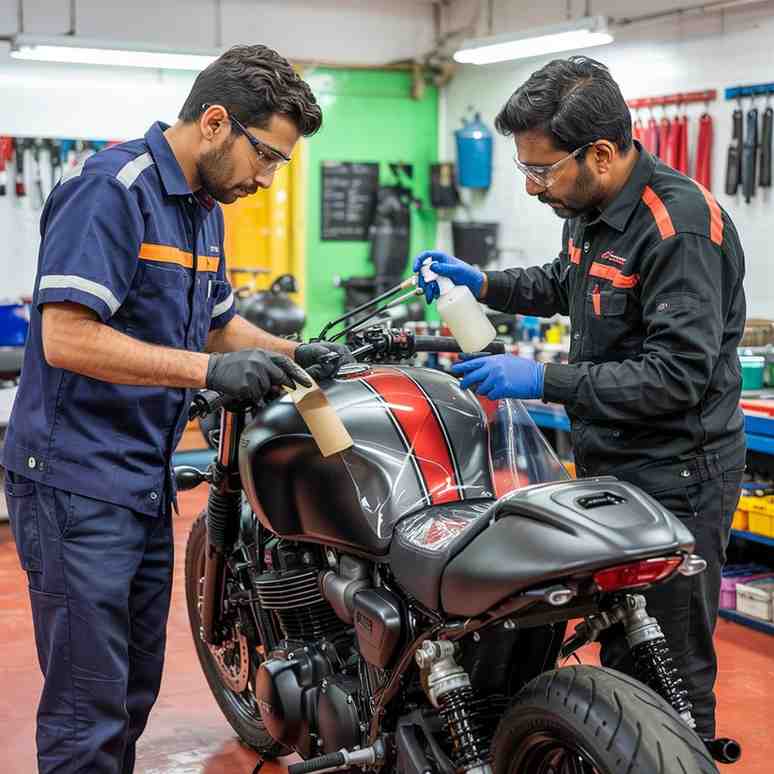Introduction
Motorcycles are more than just a mode of transport—they are a passion for many riders. Whether you own a high-performance sports bike or a classic cruiser, maintaining its appearance and protecting it from scratches, stone chips, and environmental damage is crucial. One of the best ways to achieve this is by applying Paint Protection Film (PPF). But with various types of PPF for bikes available, how do you know which one is best for you?
PPF comes in different varieties, each designed to cater to specific needs. From self-healing PPF for bikes to high-gloss and matte finishes, the choice depends on factors like durability, aesthetics, and budget. In this comprehensive guide, we will explore the different types of PPF for bikes, their benefits, and how to choose the best PPF for bikes that suits your riding style and protection needs.
Choosing the Best PPF for Bikes: Complete Guide
1. Glossy PPF for Bikes
What is Glossy PPF?
Glossy PPF is a transparent, high-shine film that enhances the natural gloss of your bike’s paint while protecting it from damage. It is ideal for riders who want to maintain their bike’s factory-fresh look without compromising on protection.
Benefits of Glossy PPF:
- Enhances the shine of the bike’s paint.
- Protects against minor scratches, rock chips, and UV rays.
- Provides a hydrophobic effect, making cleaning easier.
- long-lasting durability with proper maintenance.
Best Suited For:
- Sportbikes and luxury motorcycles with high-gloss finishes.
- Riders who prefer a showroomlike shine.
- Those looking for easy maintenance and added UV protection.
2. Matte PPF for Bikes
What is Matte PPF?
Matte PPF is designed for motorcycles with a matte paint finish or those who prefer a stealthy, nonreflective look. It provides the same level of protection as glossy PPF but maintains the matte effect of the bike’s paint.
Benefits of Matte PPF:
- Preserves the original matte finish without adding gloss.
- Protects against scratches, stains, and environmental damage.
- Prevents fading caused by UV exposure.
- Easy to clean and maintain compared to raw matte paint.
Best Suited For:
- Matte-finished bikes or riders who prefer a stealthy look.
- Custom builds and high-end motorcycles with unique color schemes.
- Riders who want a modern and aggressive aesthetic.
3. Self-healing PPF for Bikes
What is self-healing PPF?
self-healing PPF is an advanced type of protection film that can repair minor scratches and swirl marks on its own when exposed to heat. This type of PPF is highly durable and is ideal for riders who frequently encounter rough terrains or urban traffic.
Benefits of self-healing PPF:
- Automatically repairs minor scratches and swirl marks.
- Provides superior protection against abrasions and impacts.
- Offers UV resistance to prevent paint fading.
- Hydrophobic properties make it easier to clean and maintain.
Best Suited For:
- Adventure bikes and offroad motorcycles that face rough terrains.
- High-end sport-bikes and touring motorcycles.
- Riders who want long-term durability and hasslefree maintenance.
4. Ceramic Coated PPF for Bikes
What is Ceramic Coated PPF?
Ceramic-coated PPF combines the benefits of PPF with a ceramic coating layer, offering an extra level of protection. It enhances the hydrophobic properties of the film, making it resistant to dirt, water, and other contaminants.
Benefits of CeramicCoated PPF:
- Superior hydrophobic properties for easier cleaning.
- Increased resistance to chemical stains and UV damage.
- Provides additional gloss and smoothness.
- Enhances the longevity of the PPF and bike paint.
Best Suited For:
- Riders who frequently travel in extreme weather conditions.
- Those looking for the highest level of paint protection.
- Motorcycles used for long-distance touring or daily commuting.
5. Colored PPF for Bikes
What is Colored PPF?
Colored PPF adds an extra layer of style by allowing riders to change the appearance of their bikes while protecting the original paint. Available in various shades and finishes, colored PPF is a great option for customization.
Benefits of Colored PPF:
- Allows customization without repainting the bike.
- Offers the same level of protection as clear PPF.
- Can be removed or replaced without damaging the original paint.
- Available in matte, gloss, and metallic finishes.
Best Suited For:
- Riders who want a unique and custom look.
- Those looking for a temporary color change without committing to paint.
- Enthusiasts who frequently modify their bikes.
6. TPU vs. PVC PPF for Bikes
When choosing the best PPF for bikes, understanding the material is crucial. The two most common materials used in PPF are Thermoplastic Polyurethane (TPU) and Polyvinyl Chloride (PVC).
TPU PPF:
- More flexible and durable.
- self-healing properties available.
- Better clarity and finish.
- Resistant to yellowing over time.
PVC PPF:
- More affordable but less durable.
- Prone to cracking and yellowing over time.
- Lacks self-healing properties.
- Suitable for short-term use or budget-conscious riders.
Best Suited For:
- TPU PPF: Recommended for riders who want long-lasting protection and premium quality.
- PVC PPF: Ideal for temporary use or budget-friendly options.
How to Choose the Best PPF for Bikes
Selecting the right PPF for your bike depends on several factors, including:
- Riding Conditions: If you frequently ride in off-road conditions, opt for self-healing PPF or TPUbased protection.
- Aesthetic Preference: Choose between glossy, matte, or colored PPF depending on your bike’s design.
- Budget: TPU PPF is more expensive but offers better longevity, while PVC PPF is more affordable but less durable.
- Maintenance Needs: Ceramic-coated PPF requires less frequent cleaning and offers superior protection against contaminants.
Additional Insights on PPF Application and Longevity
Proper installation of PPF is crucial for ensuring its durability and performance. A professional application prevents issues like air bubbles, lifting edges, and uneven adhesion, which can lead to premature peeling. Choosing the best PPF for bikes depends on factors like riding conditions and maintenance preferences.
There are different types of PPF for bikes, including standard, ceramic-coated, and self-healing PPF for bikes. Self-healing PPF is ideal for riders who frequently face scratches or minor abrasions, as it automatically repairs surface damage when exposed to heat. Regular maintenance with pH-neutral cleaners and microfiber cloths helps retain the film’s clarity and longevity.
For riders who encounter extreme weather or rough terrains, investing in high-quality PPF reduces the need for frequent paint corrections, ensuring long-term protection. Whether commuting daily or going on long touring trips, the right PPF application keeps your bike looking new and well-maintained for years.
Conclusion
Applying PPF for bikes is an excellent way to protect your motorcycle’s paint and maintain its showroomlike appearance. With multiple options available, including self-healing PPF for bikes, glossy, matte, ceramic-coated, and even colored PPF, the choice depends on your specific needs and preferences.
For the best PPF for bikes, consider factors such as durability, material composition (TPU vs. PVC), and intended usage. Whether you are a daily commuter, an adventure enthusiast, or a sportbike rider, investing in high-quality PPF ensures long-term protection and enhances the overall riding experience.
Before finalizing your choice, consult with a professional installer to determine which PPF suits your bike best. With the right protection film, you can ride confidently, knowing your motorcycle is safeguarded against scratches, chips, and environmental damage for years to come.



